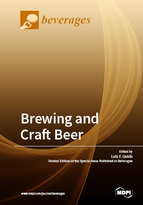Brewing and Craft Beer
A special issue of Beverages (ISSN 2306-5710).
Deadline for manuscript submissions: closed (28 February 2019) | Viewed by 70913
Special Issue Editor
Interests: analytical chemistry; bioanalytical chemistry; chromatography; mass spectrometry; food chemistry; food analysis; food control; food quality
Special Issues, Collections and Topics in MDPI journals
Special Issue Information
Dear Colleagues,
Beer is a beverage with more than eight thousand years of history, and the process of brewing has not changed so much over the centuries. However, important technical advances have allowed us to produce beer in a more sophisticated and efficient way. The proliferation of specialty hop varieties has been behind the popularity of craft beers seen in the last few years around the world. Craft brewers interpret historic beer with unique styles. Craft beers are undergoing an unprecedented period of growth, and more than 150 beer styles are currently recognized.
This Special Issue, “Brewing and Craft Beer”, is aimed at giving the floor to the craft brewers who wish to share their findings, as well as to academic and industrial researchers. Coverage includes a selection of original research and current review articles related to the whole process, from cereal to beer, with particular emphasis on:
- Raw materials
- Key beer ingredients
- Specialty hops
- Malting technology
- Brewing technology
- Brewing yeast and fermentation
- Aroma and flavor
- Beer quality
- Innovative technologies
- Efficient breweries
Prof. Luis F. Guido
Guest Editor
Manuscript Submission Information
Manuscripts should be submitted online at www.mdpi.com by registering and logging in to this website. Once you are registered, click here to go to the submission form. Manuscripts can be submitted until the deadline. All submissions that pass pre-check are peer-reviewed. Accepted papers will be published continuously in the journal (as soon as accepted) and will be listed together on the special issue website. Research articles, review articles as well as short communications are invited. For planned papers, a title and short abstract (about 100 words) can be sent to the Editorial Office for announcement on this website.
Submitted manuscripts should not have been published previously, nor be under consideration for publication elsewhere (except conference proceedings papers). All manuscripts are thoroughly refereed through a single-blind peer-review process. A guide for authors and other relevant information for submission of manuscripts is available on the Instructions for Authors page. Beverages is an international peer-reviewed open access quarterly journal published by MDPI.
Please visit the Instructions for Authors page before submitting a manuscript. The Article Processing Charge (APC) for publication in this open access journal is 1600 CHF (Swiss Francs). Submitted papers should be well formatted and use good English. Authors may use MDPI's English editing service prior to publication or during author revisions.
Keywords
- malt
- hops
- yeast
- malting
- brewing
- fermentation
- beer styles
- efficiency






